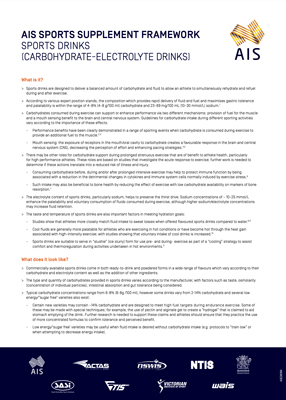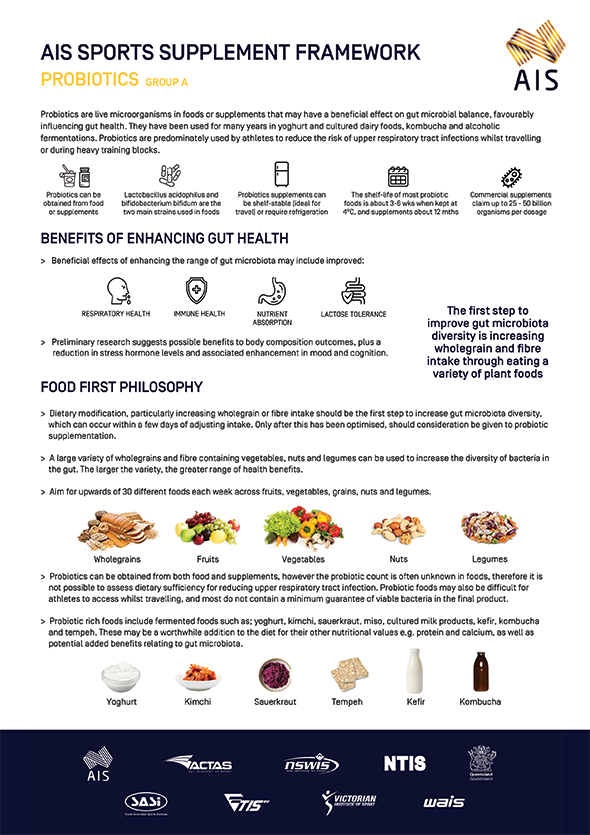Prebiotics
Prebiotics
Name / Formulation and description:
Prebiotics: A prebiotic is defined as ‘a substrate that is selectively utilized by host microorganisms conferring a health benefit.’1
Sources include ‘prebiotic-like’ foods and products that contain (one or more) concentrated extracts. Fructo -oligosaccharides (FOS), galacto-oligosaccharides (GOS), soybean- oligosaccharides, mannan oligosaccharides, xylo-oligosaccharides, inulin, partially hydrolysed guar gum, lactulose, and resistant starches (types 1, 2, 3, and 4).
The doses used in studies demonstrating a significant alteration in microbial composition and metabolism, vary greatly and are individual-microbiome dependent.
Current AIS Supplement Framework Classification: N/A Agreed AIS Supplement Framework Classification: Group B

Supplement-fact-sheet-Prebiotics.pdf

Athlete infographics have been developed for the information of athletes under the direct guidance of a sports dietitian. Sports dietitians have expert knowledge of sports supplements and their potential application in an athletes broader health and performance nutrition strategies. Always engage with a sports dietitian when considering the use of any supplement. https://www.sportsdietitians.com.au/#find-sports-dietitian, opens in a new tab
Prebiotics are substrates selectively utilised by the host microbiome conferring a health benefits to the host. They may:
- Enhance gastrointestinal immune function and competitive inhibition of pathogens (help an athlete be more resistant to infections i.e., traveller’s diarrhoea2 and UTIs)
- Improve bowel function3
- Have some anti-colon cancer properties3
- Have some lipid lowering effects4
- Improve glucose tolerance4
Consumption of prebiotic like foods and/or prebiotic supplements balance and restore a dysbiotic gastrointestinal environment caused by negative factors including diet, certain medication use, physical and psychological stressors.
While complex, it is thought they do this by increasing microbial diversity and key bacterial species that produce a variety of end products including short chain fatty acids.
Prebiotic mechanisms:
- increase Bifidobacterium spp.
- increase lactobacillus spp.
- increase faecalibacterium prausnitzi,
- increase in Roseburia spp.
- increase in Eubacterium spp.
- decrease beta-glucuronidase activity
- decrease faecal concentrations of protein putrefactive by products and pathogenic bacteria
Most human studies evaluating the effects of prebiotics have explored effects on the composition of the gastrointestinal microbiota. These studies report significant increases in Bifidobacterium and to a lesser-degree Lactobacillus bacterium and Faecalibacterium prausnitzi, Roseburia and Eubacterium spp. and their by-products.
The main prebiotics researched are fructo-oligosaccharides (FOS), galacto-oligosaccharides (GOS), lactulose and partially- hydrolysed guar gum.
Taking Lactulose, GOS and FOS have all been found to be effective in the management of constipation. GOS have been found to reduce the incidence of ‘traveller’s diarrhoea and FOS to reduce the severity of diarrhoea.
Administration of lactulose or oligofructose-enriched inulin has been found to reduce beta-glucuronidase activity (protective against colon cancer).
Lactulose has been shown to reduce incidence of urinary tract infections.
Inulin plus oligofructose has been shown to significantly improve calcium absorption in women. and promote satiety
- Prebiotic foods and ingredients used in products are considered safe.
- The ‘capacity’ of a prebiotic ingredient to exert an effect on the microbial ecosystem is dependent on the microbes present in the gut to ferment them.
- The main adverse effects are gastrointestinal symptoms of bloating, distension, and increased flatulence.
- Effect on sport performance is varied, because of a high degree of inter-individual variation in response.
- There remain some conflicting results regarding therapeutic outcomes e.g., FOS has not shown benefits in reducing symptoms of irritable bowel syndrome but GOS has.
- Allergies to prebiotics ingredients are rare but have been reported.
Group C
- Gibson, G. R. et al. (2017). Expert consensus document: The International Scientific Association for Probiotics and Prebiotics (ISAPP) consensus statement on the definition and scope of prebiotics. Nature reviews Gastroenterology & Hepatology, 14, 491.
- De Preter, V. et al. (2008). Effect of dietary intervention with different pre-and probiotics on intestinal bacterial enzyme activities. European Journal of Clinical Nutrition, 62, 225-231.
- Vulevic, J., Juric, A., Tzortzis, G. & Gibson, G. R. (2013). A mixture of trans-galactooligosaccharides reduces markers of metabolic syndrome and modulates the fecal microbiota and immune function of overweight adults. The Journal of Nutrition, 143, 324-331.
- Cummings, J., Christie, S. & Cole, T. (2001). A study of fructooligosaccharides in the prevention of travellers’ diarrhoea. Alimentary Pharmacology & Therapeutics, 15, 1139-1145.